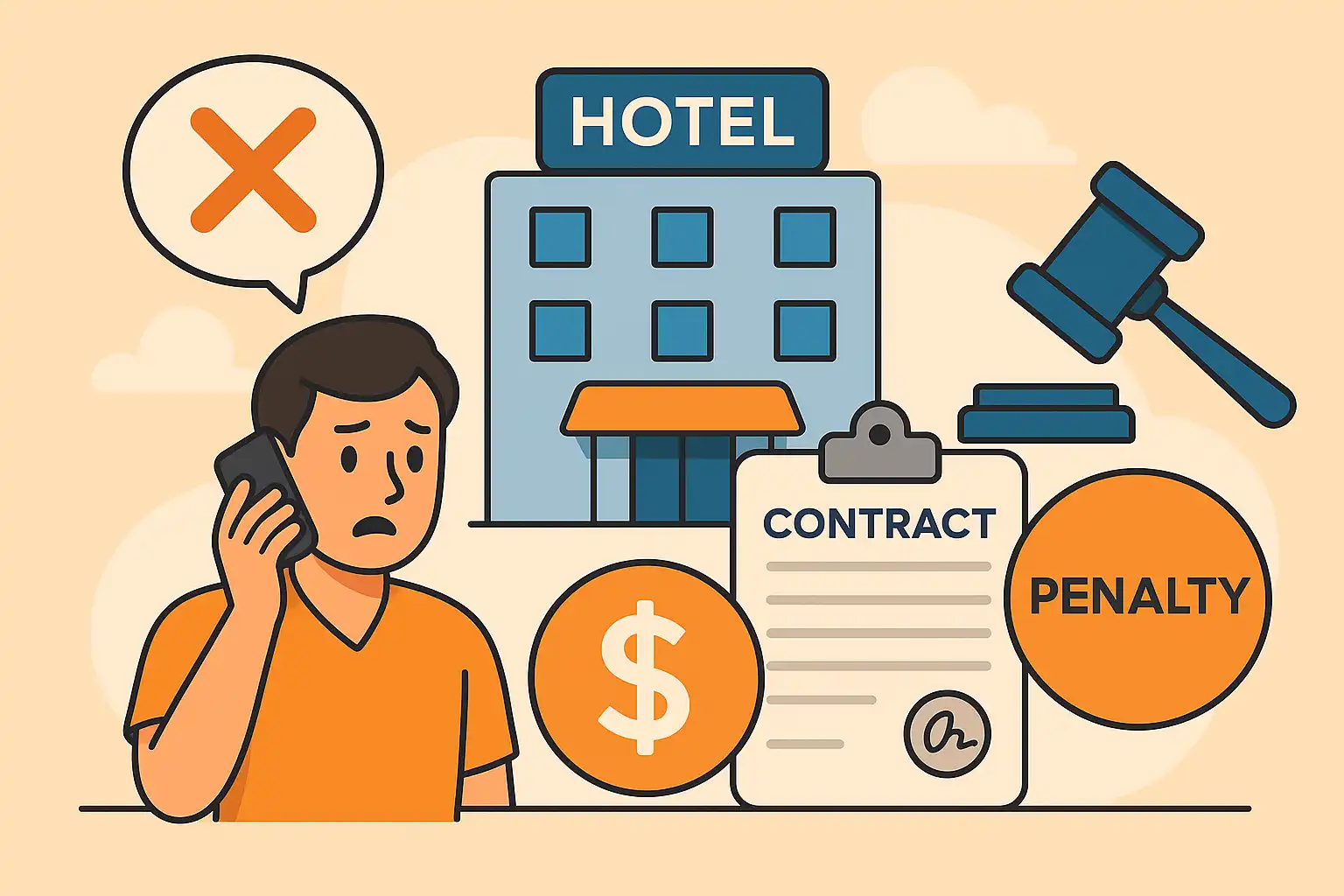Hotel Attrition: How to Manage Hotel Contract Penalties
 Mika Takahashi
Mika Takahashi Mika Takahashi
Mika TakahashiPlanning a corporate conference for 500 people? The last thing you want is a surprise $15,000 bill for unused hotel rooms. Yet, this happens more often than you'd think. Attrition penalties can hit your event budget hard if you don’t understand how they work.
Hotel attrition is one of the biggest financial risks in group event management. Many planners only learn about it when facing unexpected charges. Whether you’re organizing a multi-day conference, a wedding, or a corporate retreat, knowing how attrition clauses operate can save you thousands.
This guide breaks down hotel attrition—from what it means to how you can negotiate smarter contracts and avoid costly penalties.

Hotel attrition is the penalty you face when your group doesn’t use the minimum number of rooms promised in your hotel contract. When you reserve a room block, you’re committing to a certain number of rooms and nights. The attrition clause protects the hotel from losing revenue if you fall short.
Hotels often turn away other guests once your block is reserved, so they rely on your commitment. If you end up using far fewer rooms than expected, they lose out on potential revenue—especially during busy seasons.
For example, say you contract 200 rooms but only use 140. If the room rate is $150 per night and your event lasts three nights, that’s 60 unused rooms × $150 × 3 nights = $27,000 in potential hotel attrition fees. Many contracts allow some wiggle room—usually 10-20% attrition—but going beyond that can cost you.
Here’s a real-world scenario: You book 100 rooms at $150 per night for three nights with an 80% attrition clause. That means you’re on the hook for at least 80 rooms each night. If you only use 65 rooms per night, you owe for 15 unused rooms across three nights — $6,750 extra.
Different contracts calculate attrition differently. Knowing the type you’re dealing with helps you manage your risk and negotiate better terms.
Also called per night attrition, this requires meeting your room commitment every single night. For example, if you have a 50-room block with an 80% nightly attrition clause, you must pay for at least 40 rooms each night—even if you fill more rooms on other nights.
This leaves little flexibility. Say your event has low attendance on arrival and departure days but peaks in the middle. You’ll still pay penalties for those lighter nights. For many planners, this is the riskiest clause.
Mini-example: A front desk manager once saw a group with nightly attrition struggle on the first night when only 30 of 50 rooms were used, resulting in penalties—even though the next two nights were fully booked.
This is the most common and preferred method. It looks at your total room nights over the event, not night-by-night.
Say you book 100 rooms for 4 nights (400 room nights) with 80% cumulative attrition. You’re responsible for at least 320 room nights total, regardless of how many rooms are used each night. If your attendance dips early but picks up later, you can still avoid penalties.
This method matches real-world attendance patterns better and reduces financial risk.
This method focuses on total room revenue, not just rooms used. If your group books fewer rooms but at higher rates, you might still meet your revenue commitment.
It’s useful when your block includes different room types or fluctuating seasonal rates. However, it’s more complex to calculate and track.
Hotels often bundle revenue-based attrition with food and beverage minimums, making the overall contract more comprehensive.
At its simplest, the penalty equals: (Contracted rooms - Actual rooms used) × Group rate × Number of nights.
But real contracts add layers: cutoff dates, resale clauses, and attrition type all affect the final number.
Cutoff dates usually fall 30-90 days before your event. They’re the last chance to reduce your room block without penalty. Some contracts use stepped attrition schedules—like allowing you to release 20% of rooms 90 days out, 15% at 60 days, and 10% at 30 days.
Resale clauses are critical. They require hotels to try selling your unused rooms to other guests. If successful, your penalty is reduced dollar-for-dollar.
But beware: vague wording like “reasonable efforts” won’t protect you much. Strong contracts require documented resale attempts and priority selling of your unused rooms before walk-ins.
Timing matters too. Rooms released closer to the event are harder to resell. That’s why monitoring your room pickup early and communicating with the hotel is key.
Other factors include no-shows, room type substitutions, and rooms booked outside your block. Some contracts credit these toward your commitment if properly tracked.

Negotiation is your best tool to limit attrition risk. The terms you agree on set the stage for your entire event budget.
Right now, hotels are competing harder for hotel group business. This gives you leverage to ask for better terms if you know what to request.
Pro tip: When negotiating, ask that any attrition penalties be applied to your final invoice. This keeps your budget transparent and manageable.
Avoiding attrition fees isn’t just about the contract. It’s a continuous process from planning through post-event.
After your hotel event, audit the hotel’s in-house guest list against your registration to ensure all rooms count toward your block. Sometimes attendees book outside your block but still stay at the hotel—getting credit for these rooms can reduce penalties.
Negotiate penalty reductions based on how well the hotel resold unused rooms. And apply lessons learned to future contracts.
Myth vs Reality
Myth: “Attrition penalties are unavoidable and hotels won’t budge.”
Reality: Hotels want repeat business. With good communication and negotiation, you can often reduce or avoid penalties—especially if you’re proactive.

The hospitality industry has adapted post-pandemic. Hotels now offer more flexible attrition terms, recognizing the uncertainty in travel and attendance.
Force majeure clauses and graduated penalties are more common. Revenue managers often prioritize long-term relationships over strict enforcement, especially for repeat clients.
Technology is transforming room block management. Real-time dashboards, AI predictions, and mobile booking simplify tracking and reduce surprises.
Emerging alternatives like vacation rentals and serviced apartments also pressure hotels to rethink rigid attrition clauses.
Hybrid events reduce overnight stays, prompting hotels to adjust attrition models accordingly.
Looking ahead, expect more flexible, revenue-sharing contracts that balance risk between hotels and groups. Event planners who understand these trends and negotiate accordingly will protect their budgets best.
Hotel attrition can feel like a minefield, but understanding how it works puts you in control. Know your contract’s attrition type, monitor your room pickup early, and negotiate terms that give you flexibility.
Remember these points:
By staying informed and proactive, you’ll keep your event budget intact and build stronger hotel partnerships.
Ready to take control of your hotel contracts? Start by reviewing your current attrition clauses and setting up regular pickup monitoring today.